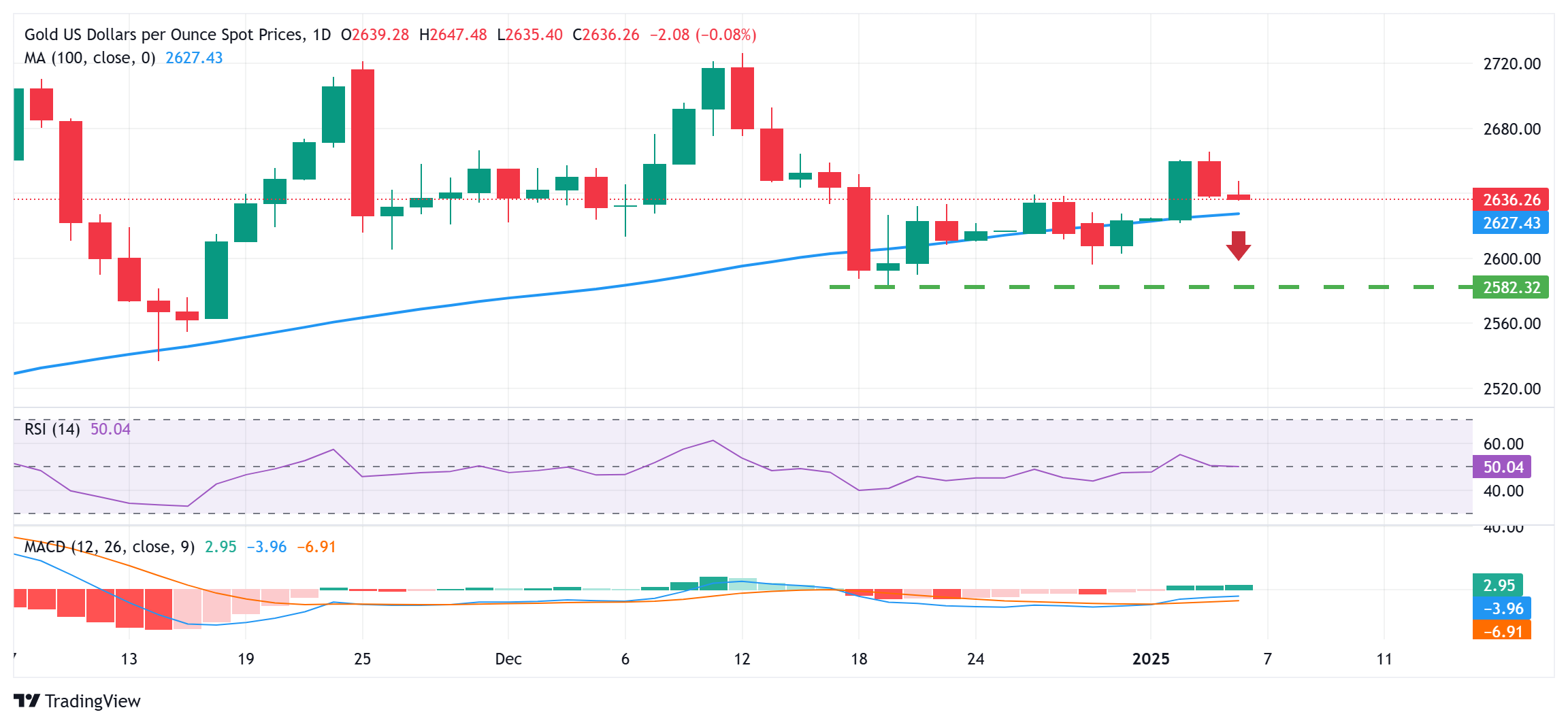Gold price moves away from multi-week high on hawkish Fed expectations
- Gold price turned lower for the second straight day on Monday, though the downside seems limited.
- The Fed’s hawkish signal remains supportive of elevated US bond yields and exerts some pressure.
- Geopolitical risks and trade war fears might continue to offer support to the safe-haven XAU/USD.
Gold price (XAU/USD) struggles to capitalize on its modest Asian session uptick on Monday and currently trades around the $2,635 area, down for the second straight day. The US Dollar (USD) remains close to a two-year high touched last Thursday on the back of the Federal Reserve's (Fed) hawkish signal that there would be fewer rate cuts in 2025. Moreover, the optimism over US President-elect Donald Trump's expansionary policies continues to underpin the Greenback, which, in turn, is seen acting as a headwind for the non-yielding yellow metal.
That said, persistent geopolitical risks stemming from the protracted Russia-Ukraine war and tensions in the Middle East, along with concerns about Trump's tariff plans, should limit losses for the safe-haven Gold price. This, in turn, makes it prudent to wait for a strong follow-through selling before positioning for an extension of Friday's retracement slide from the $2,665 area, or a nearly three-week top. Traders now look forward to the release of the final US Services PMI and Factory Orders data for some impetus later during the North American session.
Gold price is undermined by the prospects of a slower pace of rate cuts by the Fed
- The Institute of Supply Management (ISM) reported on Friday that the US Manufacturing PMI improved from 48.4 to 49.3 in December, pointing to signs of resilience and potential for growth.
- This comes on top of the prospects for a slower pace of rate cuts by the Federal Reserve in 2025 and remains supportive of elevated US Treasury bond yields, undermining the Gold price.
- The yield on the benchmark 10-year US government bond reached its highest point since May 2 and assists the US Dollar in holding steady just below a two-year high touched last Thursday.
- San Francisco Fed President Mary Daly said on Saturday that despite significant progress in lowering price pressures over the past two years, inflation remains uncomfortably above the 2% target.
- Investors this week will confront the release of important US macro releases, including the closely-watched Nonfarm Payrolls report on Friday, ahead of the next Fed meeting later this month.
- Israeli forces continued to attack medical facilities in the Gaza Strip and more Israeli raids were reported in the occupied West Bank on Sunday, while the Houthis have intensified their attacks on Israel.
- Ukraine said on Sunday that it had carried out surprise attacks against Russian forces in several areas in Kursk. The Russian Defence Ministry also confirmed the Ukrainian counterattacks.
Gold price could retest December swing low once the 100-day SMA support is broken
From a technical perspective, any subsequent slide is likely to find decent support near the 100-day Simple Moving Average (SMA), currently pegged near the $2,625 region. This is followed by the $2,600 mark, below which the Gold price could drop to the December monthly swing low, around the $2,583 area. Some follow-through selling will be seen as a fresh trigger for bearish traders and pave the way for deeper losses.
On the flip side, momentum beyond the Asian session high, around the $2,647 region, could lift the Gold price back to the $2,665 area, or the multi-week high. The subsequent move up could extend further towards an intermediate resistance near the $2,681-2,683 zone en route to the $2,700 mark. The latter should act as a pivotal point, which if cleared decisively will set the stage for an extension of a two-week-old uptrend.
Gold FAQs
Gold has played a key role in human’s history as it has been widely used as a store of value and medium of exchange. Currently, apart from its shine and usage for jewelry, the precious metal is widely seen as a safe-haven asset, meaning that it is considered a good investment during turbulent times. Gold is also widely seen as a hedge against inflation and against depreciating currencies as it doesn’t rely on any specific issuer or government.
Central banks are the biggest Gold holders. In their aim to support their currencies in turbulent times, central banks tend to diversify their reserves and buy Gold to improve the perceived strength of the economy and the currency. High Gold reserves can be a source of trust for a country’s solvency. Central banks added 1,136 tonnes of Gold worth around $70 billion to their reserves in 2022, according to data from the World Gold Council. This is the highest yearly purchase since records began. Central banks from emerging economies such as China, India and Turkey are quickly increasing their Gold reserves.
Gold has an inverse correlation with the US Dollar and US Treasuries, which are both major reserve and safe-haven assets. When the Dollar depreciates, Gold tends to rise, enabling investors and central banks to diversify their assets in turbulent times. Gold is also inversely correlated with risk assets. A rally in the stock market tends to weaken Gold price, while sell-offs in riskier markets tend to favor the precious metal.
The price can move due to a wide range of factors. Geopolitical instability or fears of a deep recession can quickly make Gold price escalate due to its safe-haven status. As a yield-less asset, Gold tends to rise with lower interest rates, while higher cost of money usually weighs down on the yellow metal. Still, most moves depend on how the US Dollar (USD) behaves as the asset is priced in dollars (XAU/USD). A strong Dollar tends to keep the price of Gold controlled, whereas a weaker Dollar is likely to push Gold prices up.

